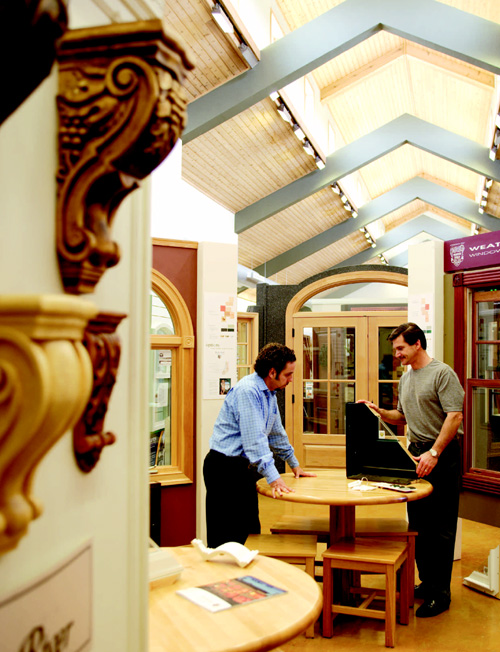Serving consumers comes with another hitch, too: finding the right location. “It’s crucial that the facility is in an area that consumers feel comfortable coming to,” says Doug Bohannon, president of seven-unit, Hyannis, Mass.–based Mid-Cape Home Centers, which launched a 12,500-square-foot showroom in 2003 beside an Ethan Allen store. “You can’t put these things in an industrial park next to a truck maintenance farm.”
The upside of tending to that homeowner’s notebook full of specs and shopping-center soul comes when you take the sales burden off your customers’ shoulders to let them do what they do best: build. “If I can get an expert in the showroom describing how something works to my client, it makes them think I’m a better builder,” says Jesse Warder, owner of San Antonio–based high-end custom builder Jess Warder & Son Homebuilders, who regularly sends his clients to Allen & Allen’s showroom. “Even though I’m not [the one] explaining it, they make me look good.”
If consumer hand-holding and keeping abreast of changing product features in real-time sounds daunting, take heart: The showroom-minded dealer is not alone. Product vendors and distributors are usually happy to educate your sales force on the specs, selling points, and functionality of their products. And with special financing terms, rebates, and co-op programs in areas such as advertising, vendors can kick in financially, too. “They want to get their product in front of people and in your store, so they’re going to be willing to help you with it,” says Coleman. “It’s just a matter of sitting down with them and seeing what they’re willing to do.”
Subscribing to the showroom business model isn’t all tough decisions, however. Since the homeowner is usually selecting and approving the order up front, returns are often minimal. And by selling specialty products, you’re boosting profits. “Margins are always going to be better on millwork than on lumber, usually by 10 percent or more,” attests Mid-Cape’s Bohannon, whose showroom displays windows and doors from Andersen, doors from Therma-Tru, Baldwin hardware, and KraftMaid kitchen and bath cabinets. “But it goes beyond that. We’ve seen a 50 percent increase in kitchen cabinet sales alone. So it’s not just millwork, it’s a combination of everything we have to offer.”
Bohannon is so committed to the showroom business model that he’s currently tricking-out a 38-foot, diesel-pusher bus to take Mid-Cape’s modeling on the road. “We’ve got a lot of architects in Boston who hate to leave their offices,” he explains. “So we’re going to go to them.”
Keeping It Sexy On the road or not, a successful showroom still boils down to one thing: Its “wow” factor. Without the punch of a twin-curved monumental stair, an architectural village, bathroom bonanza, or other eye-catching centerpiece, your showroom just won’t sizzle, according to dealers in the know. Many turn to an architect to help them design their showroom. With facilities today including wide-ranging features such as Internet-connected conference rooms and large drafting tables that homeowners, builders, and architects can use to pick out products, getting input from an end-user also makes sense.
Other successful planning strategies include looking through trade publications and visiting other showrooms while you travel to get ideas for what might work for you. Keep designs flexible, and make sure the completed showroom is easy to update. Some dealers also opt for moveable displays that are easy to set up and break down at home shows, notes Coleman.
But don’t forget who you are; a good showroom stresses the strengths of the company behind it. “Some designers were trying to make us something we’re not,” says Gerry Wille, vice president of operations at $260 million, Buffalo Grove, Ill.–based Edward Hines Lumber Co., which made an $800,000 investment in a 6,000-square-foot showroom in Libertyville, Ill., in 2003. “We knew we weren’t going to be showing 2x4s and OSB in there, but we still wanted it to be warm and to say ‘us.’ In the end, we got to show off our fine custom millwork, our kitchen cabinets, and hardwood floors. We even snuck in some cedar paneling.”
Finally, when it comes to building a showroom, successful pro dealers subscribe to the theory that size really does matter—square footage is not the place to skimp. “We’ve got over 9,000 square feet of showroom space, so we’ve got plenty of elbow room, but we certainly wouldn’t want to give any of it away,” says Danny McQuary, director of finance for BMC West, a division of San Francisco–based, $2.1 billion BMHC. McQuary oversaw construction of the firm’s Coppell, Texas, showroom, launched in 2003 with a $200,000 product investment. He estimates the showroom adds $300,000 a month in incremental sales.
As the sales roll in, just remember to keep things fresh. “The only problem with having a showroom is you’ve got to keep it updated,” says Coleman. “In our business, you’ve got to stay in front of the changes as they come along. And that’s just hard to do, because it takes time.” But by taking the right steps along the showroom route, pro dealers can happily adjust to other changes, as well: increased revenue, higher margins, and better customer satisfaction. —Joe Bousquin is a Newcastle, Calif.–based business journalist.

